The third in a series of posts that looks at the history of the central Christchurch sites on which your new library, Tūranga, has been built.
Next to Cathedral Chambers/Hobbs' Corner was the home of the Lyttelton Times and the Star.
The Lyttelton Times originally set up in Lyttelton with the printing press that arrived on the Charlotte Jane, one of the ‘first four ships, opens a new window’. They published their first paper 26 days after the printing press arrived in 1851 and the run continued till 1935. For a taste of the Times, we have digitised the first issue, 11 January 1851, for you to read online. Marvel at the adds for bullocks and unbroken fillies for sale and wonder at the plea by John Robert Godley, on behalf of the Canterbury Association, who were in desperate need of pickaxes and shovels.
While the headquarters started out in Lyttelton, the newspaper had an agency in Christchurch that sat around about the middle of Tūranga now. Here it is in 1859, facing Gloucester Street.
The Lyttelton Times moved its headquarters to Christchurch in 1863, after their two-storey wooden building was finished in 1862. Here’s what it looked like, if you were peering through the trees on the Square in 1863:
Come out from the trees and this is what it looked like, still facing the square:
In the photo above, taken in 1885, you can see the flagstaff that was used to signal to the people of Christchurch when ships arrived in the port over the hills. If you knew the code, opens a new window, you could be in the Square and know that a brig was arriving from the North by the blue flag that would be waving at the head of the mast. Very handy if you knew which ship brought in the mail! It was an important spot in Christchurch for staying connected with the outside world.
On the right side of the photo is Warner’s hotel (where the Novotel is now) whose guests would complain about the noise of the printing press lasting long into the night (this wing of Warner's was eventually demolished and replaced with a theatre (The Liberty, later The Savoy), the building intended to act as a buffer for sound and vibration. In later years the situation would be reversed. Following the demolition of the theatre, vacant space between the buildings became a beer garden for Warner's hotel and bar, while the Times building by then had been converted to backpackers' accommodation. Band performances and music in the beer garden were required to stop at a reasonable hour in order not to disturb the sleep of the guests in rooms next door. Later still, this wing of the building would be reinstated, and is now the only part of Warner's that remains.
On the left in the above image is Cathedral Chambers. The taller building behind the Lyttelton Times was still part of the Lyttelton Times premises, which was added in 1884. While it looks fairly drab from behind, it’s pretty spectacular facing Gloucester Street. Here’s the handsome frontage (134-140 Gloucester St) in 1884:
Somewhat confusingly the building was home to 3 newspapers (the titles of which can be seen engraved into the front of the building): The Lyttelton Times, The Canterbury Times (a weekly started in 1865), and The Star (an evening paper started in 1868). All 3 papers were produced by the Lyttelton Times Company, and for different audiences and purposes.
You could also head down to the Lyttelton Times building to get things printed, just like you can do in Tūranga. We too can boast a large assortment of plain and fancy types, just like Ward and Reeves, the printers who worked from Lyttelton Times Office building.
Well the Lyttelton Times, they kept a-changing, and by 1903 had grown into the majestic beast below, with an addition designed by the Luttrell Brothers on the Cathedral Square side becoming the first building in New Zealand to adopt the Chicago skyscraper style. It was also known as 'gingerbread style' or even 'streaky bacon style'. You can see why looking at the colour pictures of it - it does have a kind of foody look to it. With Oamaru stone facings on a Post Chalmers bluestone base, it was the tallest building on the Square at the time it was built. Here's the new building decorating its corner of the square in 1904, a black and white photograph from our collection and a pen and ink watercolour by Raymond Morris:
The Lyttelton Times changed its name to the Christchurch Times in 1929, then stopped publishing in 1935 because the competition was too great. When it ended, it was the oldest newspaper in the country. The building was still used for newspapers though – New Zealand Newspapers Ltd, formerly the Lyttelton Times Company, kept publishing the evening Star-Sun, which had started as the Star in 1868. In 1958 the Star-Sun moved out of this building to a new location in Kilmore Street, and changed its name to the Christchurch Star.
Once all the newspapers had departed, the building was occupied by several different commercial tenants over the years, including The Record Joynt and the fondly remembered Atlantis Market, described by journalist Russell Brown as "a long-gone hippie emporium". Before the 2011 earthquake, there was a Tandoori Palace restaurant on the ground floor and Base Backpackers above. On the Gloucester Street side, the ground floor was home to a number of restaurants including Samurai Bowl, O-cha Thai, and Le Pot Au Feu. By August that year the building would be demolished.
The connection of the site to Christchurch's historical newspapers continues in Tūranga with our collection of back copies of local newspapers on microfilm, including the Lyttelton Times and the Star. Come and visit them on Tuakiri | Identity, Level 2.
Next week: The Coachman Inn
Further reading
- Central city block, sheet no. 5 - Plan showing layout of buildings in the block containing Tūranga as they were in 1933
- Round the Square: A History of Christchurch’s Cathedral Square
- Christchurch newspapers
- 134-140 Gloucester St New Zealand Historic Places Trust
- 56 Cathedral Square New Zealand Historic Places Trust
- Our pages about Early Christchurch
- About Tūranga, Christchurch’s central library


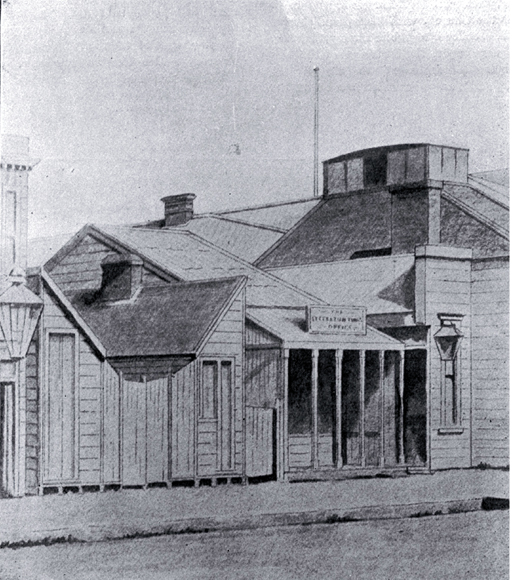
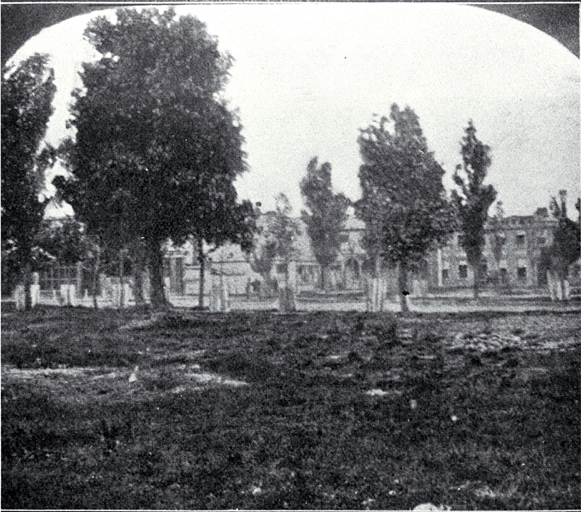
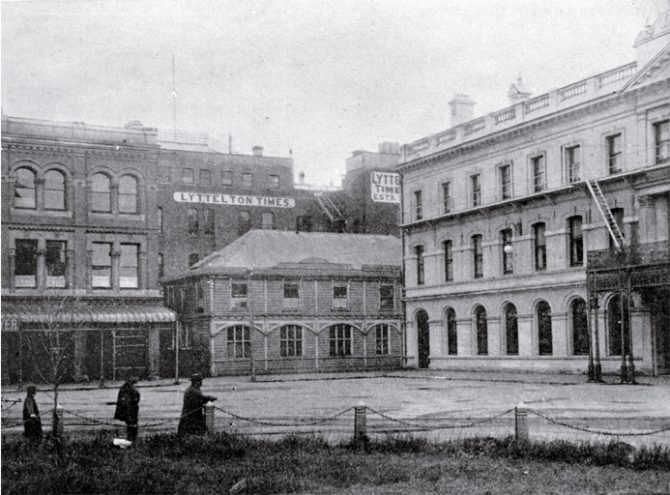
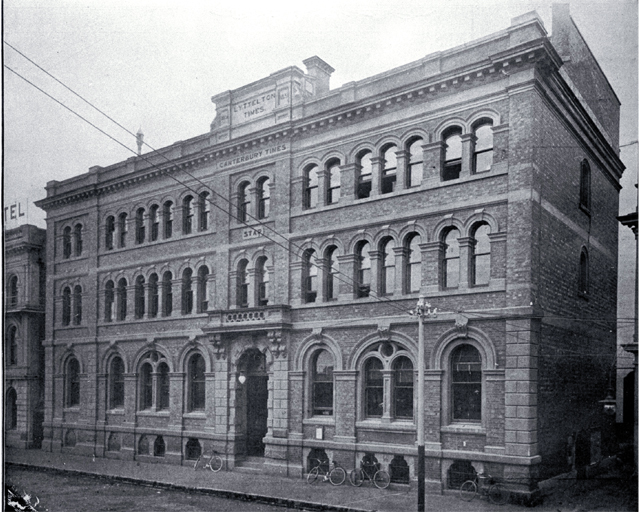

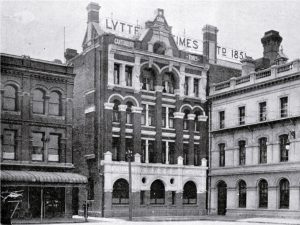
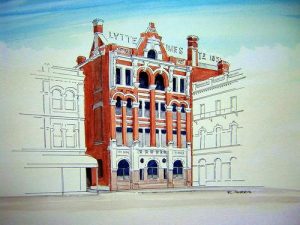
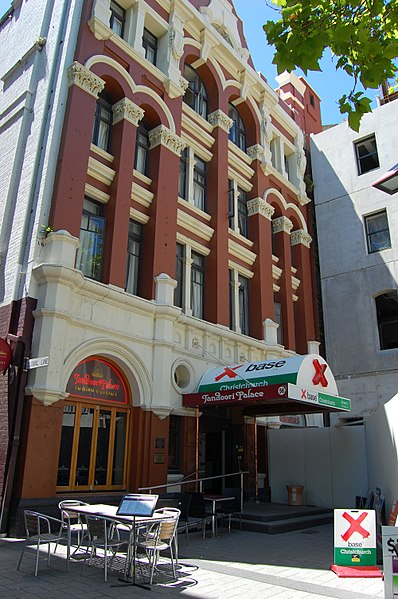

Add a comment to: Before Tūranga – The Lyttelton Times